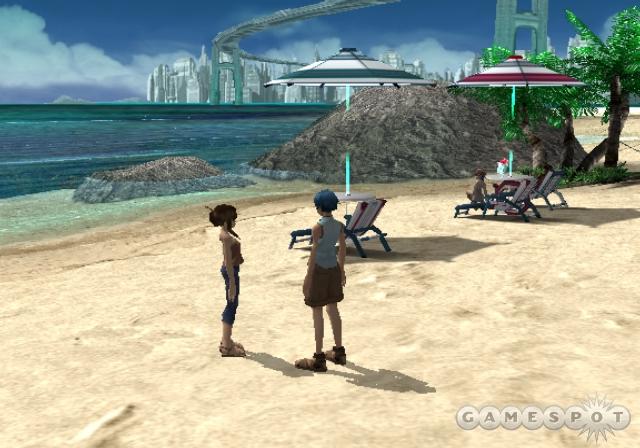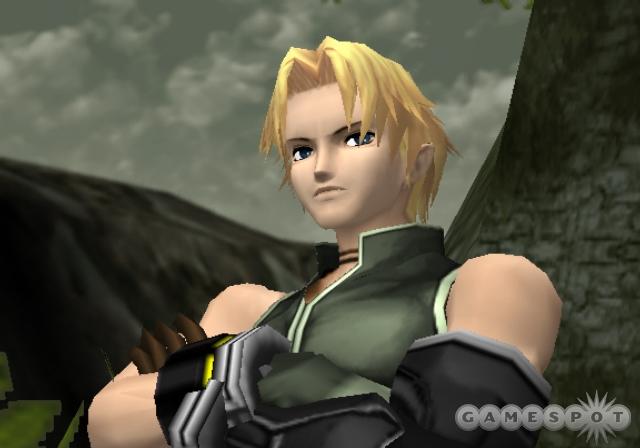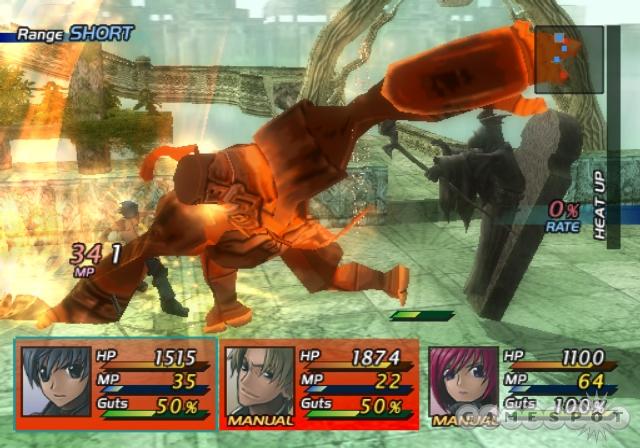Star Ocean: Till the End of Time Preview
We spend some quality time with a near-complete build of the English-language version of this sci-fi-themed, anime-inspired role-playing game from Square Enix.
If you're knowledgeable about Japanese role-playing games, then surely you've heard the name Star Ocean before. The sci-fi-themed series began nearly 10 years ago on the Super Nintendo Entertainment System and spawned a 1998 sequel for the original PlayStation. That was the first Star Ocean game to arrive in North America, and very soon, the second game will be available, exclusively for the PlayStation 2.
No previous experience with the series will be required to enjoy or appreciate Star Ocean: Till the End of Time, which is an epic console-style role-playing game comparable to the Final Fantasy series or last year's Xenosaga Episode I. Yet while this new Star Ocean has a lengthy, involving storyline the likes of which you'd expect from a game of this type, its actual gameplay seems to have a refreshingly quick pace--both for when you're exploring the game's diverse environments and for when you're fighting the dangerous foes lurking in them. But there's much more to the game that's likely going to appeal to fans of the RPG genre.
Star Ocean: Till the End of Time has actually been available in Japan since February of last year, though the imminent North American release of the game is based on a director's-cut version--a couple of the more notable extras include extended cinematic sequences, a new versus mode, and two additional player characters. At any rate, the focus of the game is still, of course, an epic role-playing adventure. You play as a young man named Fayt Leingod, and in the beginning, you'll meet Fayt along with his childhood friend, Sophia, as they're exploring a lavish, futuristic resort hotel. They're on vacation.
Needless to say, the situation turns sour. There's an attack, and the hotel residents are ordered to evacuate. Amid the turmoil, Fayt and Sophia are forced to abandon Fayt's mother and father, who they presume are killed in the attack--or perhaps captured. The situation doesn't improve much as Fayt and Sophia continue their escape aboard a rescue ship; the relentless attackers irreparably damage that vessel, forcing the civilians inside to bail out in escape pods. Fayt and Sophia are separated--Fayt finds himself crash-landed on a planet reminiscent of 15th-century Earth, and it's at this point that the sheer scope and scale of Star Ocean's adventure becomes apparent. All of this occurs within the first couple of hours of gameplay.
Like last year's Xenosaga, Star Ocean often feels like science-fiction-themed anime rather than simply like a game. It features lengthy, frequent cinematic cutscenes involving dialogue between the various main characters, and these cutscenes for the most part aren't interactive. The particular style of sci-fi on display in the game seems heavily influenced by Star Trek--teleportation devices called "transporters" are used to move people around instantly, and an organization called the Pangalactic Federation overrules a vast network of different planets. Portable translator devices allow individuals to speak with foreigners in their own, native language without any trouble. And, interestingly, the Pangalactic Federation has imposed laws requiring individuals to respect the natural evolution of various worlds--so when Fayt finds himself in a medieval environment, he's forced to conceal his identity and brandish a simple sword as a weapon so that he can blend in with the locals.

During the course of the game, Fayt and his growing number of companions will end up in a great number of other places, so the science fiction setting gave the designers of the game creative license to actually include a variety of different themes throughout. In fact, the setting of the game is so rich with detail that there's a persistent menu option called "Dictionary," which is really more of an encyclopedia about the different people, places, and organizations you've either seen or heard about.
With that said, the game's story isn't immediately captivating, since it takes its time to pick up speed, and the main characters initially come across as mundane. On the other hand, Star Ocean's fast-paced, real-time combat system is appealing right from the start. Find out all about it next.
No Random Battles, No Turns
Star Ocean: Till the End of Time is yet another role-playing game that's actively defying the genre's convention of being filled with random, lengthy, tactical turn-based battles. Here, you see your enemies on the field, and only if you run into them will combat be initiated--and you can move quickly, so it's often possible to outmaneuver your foes. Combat, of course, will often be unavoidable, but at least you can initiate the attack on your own terms. And once the fighting actually starts, you'd better be ready, because it all happens quite quickly.

You can have up to three characters in your party at a given time; two of them will be controlled by the computer while you actively manage the third. You can execute weak and heavy slashes, the former of which can be deflected, but the latter of which leave you open to counterattack. Stringing together various strikes and quickly maneuvering around the battlefield while avoiding enemy attacks is the basic key to success. But it can be much more complex than that; depending on the range from which you attack, your attacks may vary. Sometimes you can pop enemies high into the sky, setting them up for fighting-game-style juggle combos--and massive amounts of damage.
And you've got your standard role-playing trappings here, too. Though the combat practically feels like a full-on action game, you can always instantly pause to use items (to restore your characters or impair foes), use magic spells (or "symbology," as it's called in the world of Star Ocean), alter tactics, or even flee the battlefield. Changing tactics can be effective depending on the types of foes you're facing; by default, your party members will attack their enemies head on, but it may be more strategic to have them hang back and fire away with spells, or adopt an even more defensive posture. At any rate, the combat in Star Ocean is fast and quite fun from the get-go. If anything, we found ourselves wishing there were more combat in the early going; there's definitely more talk than action in the early hours of the game. One issue we had with the combat is that the isometric display angle, while tactically useful, results in characters that appear very small onscreen. A lot of the fighting does end up taking place in close quarters, and at these times, it can be difficult to tell who's hitting whom. With practice, though, we started to get a good feel for the dynamic of the fighting.
An interesting aspect of the combat is the ability to earn what are called "battle trophies," based on your performance. These aren't so much trophies as they are acknowledgements of your ability to conduct battle in a certain way--for instance, by defeating all foes within 10 seconds, by winning using only weak strikes, or by chaining together more than 10 hits in a fight. In all, there are 300 or so possible battle trophies to be earned, and acquiring all of these ought to be an interesting challenge for that particularly obsessive type of role-playing fan.
As they win battles, your characters of course gain experience points, money, and occasionally items. By gaining experience levels, characters get stronger and hardier, and they also gain new special abilities from time to time. You also earn special points for each character, which can be used to bolster their stats, such as their maximum health or their strength. Star Ocean seems to feature a satisfyingly extensive number of character customization options--especially once you've met all of the different possible party members and get to decide the makeup of your team.
At its core, Star Ocean: Till the End of Time is still a conventional Japanese-style role-playing game. It has your token noninteractive cutscenes and exploration sequences through places like towns, wilderness, and dungeons; some light puzzle solving; and, eventually, lots of combat. Of course, the fundamental difference between most all console role-playing games--which do tend to be pretty conventional--is in how well these various elements are implemented. The good news is that Star Ocean is fairly impressive from a technical standpoint. Read on to find out why.
Technically Speaking
Star Ocean boasts a clearly anime-inspired visual design that actually looks rather like last year's Xenosaga. The fully 3D game sports a clean look and a fast, smooth frame rate, and its cinematic 3D cutscenes are mostly rendered using the actual game engine. Here you'll see the characters emoting fairly well, though at times they look a little stiff or too much like mannequins.

One other issue we had with the extensive cutscenes is that, despite being noninteractive, they do force you to manually advance the dialogue line by line by pressing the X button. We ended up watching many of the cutscenes while simply tapping X, causing much of the spoken dialogue to get cut off, since we can read faster than the characters can talk. But that's OK--during the particularly important or dramatic exchanges, we of course paid close attention, and we stand ready and willing to be quizzed on all the gory details. In any case, Star Ocean is a pretty good looking game--even though it's been out in Japan for a while, you wouldn't know it from seeing these graphics today.
The game's audio is on par with its graphics. The English translation seems fine from what we've seen, and though a couple of early attempts at humor fall a bit flat, it's mostly due to the content of the jokes than the delivery. The actual English speech is less consistent in quality than the translation of the dialogue, since some characters deliver noticeably more forced-sounding performances than others. Fayt, fortunately, sounds just fine, much like the thoughtful, moral young man he's supposed to be. Some of the other characters, like the young dancer Peppita whom Fayt and Sophia meet early on, are somewhat harder on the ears, though. But all in all, Star Ocean's voice work--as well as its variety of music and sound effects--sounds much like you would probably expect from a sci-fi-themed anime.
Star Ocean has a number of much-appreciated technical options that are worth mentioning, and in fact, Star Ocean prompts you to set these even when you first begin play. You can choose to play in a 16:9 aspect ratio if you have a widescreen television; the game supports Dolby Pro-Logic II surround sound; and, unlike most RPGs, it even features three different difficulty settings--the toughest of which is initially unavailable. You also have the ability to enable cutscene skipping--a great feature for those replaying the game (or certain sequences), since it mitigates the possibility of accidentally skipping over important information, while still retaining the option for you to cut straight to the chase. There are also options for tweaking the combat, for instance by allowing the computer to target enemies for you if you'd rather not worry about prioritizing your foes yourself. Role-playing games are really all about depth and customization, so it's surprising how so few RPGs offer the breadth of options that Star Ocean has.

This game has spent a long time coming to North America, but when it's finally released later this summer, we think many RPG fans will find that the wait was worth it. While Star Ocean doesn't seem to defy the visual or story conventions of the role-playing genre, its fast-paced, action-packed gameplay may well turn out to be just the ticket for players weary of the stereotypically sluggish nature of games such as this. As such, PS2 owners looking for an epic adventure to while away the late-summer days should definitely be on the lookout for this one. For now, be sure to examine our variety of new
Got a news tip or want to contact us directly? Email news@gamespot.com
Join the conversation